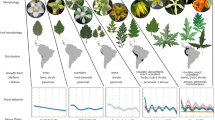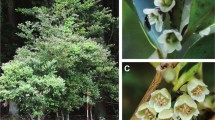Abstract
In hermaphroditic dichogamous species, sporophylls are separated in time. However, the separation of sporophylls can lead to pollination inaccuracy, especially in movement-assisted dichogamy, where sporophylls alter their position over time. Is pollination inaccuracy minimised by the second sporophyll taking the exact position of the first? We address this question in Clerodendrum infortunatum, a movement-assisted dichogamous species. We made predictions from optimality arguments, and tested these by measuring sporophyll angles over time, by experimentally manipulating flowers, and by estimating correlates of the resultant fitness, taking into account pollen export, pollination inaccuracy and the resultant total pollen delivered. Contrary to expectation, anthers do not have a fixed position in the male phase, and pollination inaccuracy is high. Further, when the number of pollen grains on anthers is highest, anthers are paradoxically not positioned at the pollen export peak. Also, pollen export and pollen deposition peaks do not align. Despite this seeming maladaptiveness, the starting position of the anthers is, in fact, very close to the theoretical optimum, which results in the highest overall male fitness, measured as the total pollen delivered over the entire male phase. Instead of a simple positional exchange of sporophylls, stamens display a more complicated dynamic strategy that appears close to optimal even though naive measures of pollination inaccuracy are high.








Similar content being viewed by others
Data availability
The datasets generated during and/or analysed during the current study are available from the corresponding author on reasonable request.
Code availability
The code used in the current study are available from the corresponding author on reasonable request.
References
Agostinelli C, Lund U (2017) R package “circular”: Circular Statistics (version 0.4–93). URL https://r-forge.r-project.org/projects/circular/. CA: Department of Environmental Sciences, Informatics and Statistics, Ca’ Foscari University, Venice, Italy. UL: Department of Statistics, California Polytechnic State University, San Luis Obispo, California, US
Alexandersson R, Johnson SD (2002) Pollinator–mediated selection on flower–tube length in a hawkmoth–pollinated Gladiolus (Iridaceae). Proc R Soc Lond B Biol Sci 269:631–636
Armbruster WS (1990) Estimating and testing the shapes of adaptive surfaces: the morphology and pollination of dalechampia blossoms. Am Nat 135:14–31
Armbruster WS, Pélabon C, Hansen TF, Mulder CPH (2004) Floral integration, modularity, and accuracy: distinguishing complex adaptations from genetic constraints. In: Pigliucci M, Preston K (eds) Phenotypic integration: studying the ecology and evolution of complex phenotypes. Oxford University Press, Oxford, UK, pp 23–49
Armbruster WS, Hansen TF, Pelabon C, Perez-Barrales R, Maad J (2009a) The adaptive accuracy of flowers: measurement and microevolutionary patterns. Ann Bot 103:1529–1545
Armbruster WS, Pélabon C, Hansen TF, Bolstad GH (2009b) Macroevolutionary patterns of pollination accuracy: a comparison of three genera. New Phytol 183:600–617
Armbruster WS, Shi X-Q, Huang S-Q (2014) Do specialized flowers promote reproductive isolation? Realized pollination accuracy of three sympatric Pedicularis species. Ann Bot 113:331–340
Barrett SCH (2002) Sexual interference of the floral kind. Heredity 88:154–159
Bazzaz FA, Grace J (1997) Plant resource allocation. Academic Press, San Diego, California, US
Bertin RI, Newman CM (1993) Dichogamy in angiosperms. Bot Rev 59:112–152
Butler HC, Johnson SD (2020) Butterfly-wing pollination in Scadoxus and other South African Amaryllidaceae. Bot J Linn Soc 193:363–374
Campbell DR (2000) Experimental tests of sex-allocation theory in plants. Trends Ecol Evol 15:227–232
Canty A, Ripley B (2017) Boot: bootstrap R (S-Plus) Functions. R package version 1.3–20
Charlesworth D, Charlesworth B (1987) Inbreeding depression and its evolutionary consequences. Annu Rev Ecol Syst 18:237–268
Charnov EL, Bull JJ, Maynard Smith J (1976) Why be an hermaphrodite? Nature 263:125–126
Chernick MR, LaBudde RA (2014) An introduction to bootstrap methods with applications to R. Wiley, Hoboken, New Jersey, US
Cresswell JE (2000) Manipulation of female architecture in flowers reveals a narrow optimum for pollen deposition. Ecology 81:3244–3249
Davison AC, Hinkley DV (1997) Bootstrap methods and their application. Cambridge University Press, Cambridge, UK
de Jong T, Klinkhamer P (2005) Evolutionary ecology of plant reproductive strategies. Cambridge University Press, Cambridge, UK
Duan Y-W, Zhang T-F, Liu J-Q (2007) Interannual fluctuations in floral longevity, pollinator visitation and pollination limitation of an alpine plant (Gentiana straminea Maxim., Gentianaceae) at two altitudes in the Qinghai-Tibetan plateau. Plant Syst Evol 267:255–265
Eckert CG, Ozimec B, Herlihy CR, Griffin CA, Routley MB (2009) Floral morphology mediates temporal variation in the mating system of a self-compatible plant. Ecology 90:1540–1548
Evert RF, Eichhorn SE (2013) Raven biology of plants. WH Freeman and Company, New York, US
Fetscher AE (2001) Resolution of male-female conflict in an hermaphroditic flower. Proc R Soc Lond B Biol Sci 268:525–529
Gray A (1879) Structural botany. American Book Company, New York, US
Green FJ (1990) Sigma-Aldrich handbook of stains, dyes, and indicators. Aldrich Chemical Co, Milwaukee, US
Hansen TF, Carter AJR, Pélabon C (2006) On Adaptive accuracy and precision in natural populations. Am Nat 168:168–181
Hargreaves AL, Harder LD, Johnson SD (2009) Consumptive emasculation: the ecological and evolutionary consequences of pollen theft. Biol Rev 84:259–276
Herrera CM (1987) Components of pollinator “quality”: comparative analysis of a diverse insect assemblage. Oikos 50:79–90
Husband BC, Schemske DW (1996) Evolution of the magnitude and timing of inbreeding depression in plants. Evolution 50:54–70
Ivey CT, Martinez P, Wyatt R (2003) Variation in pollinator effectiveness in swamp milkweed, Asclepias incarnata (Apocynaceae). Am J Botany 90:214–225
Johnson SD, Steiner KE (1997) Long-tongued fly pollination and evolution of floral spur length in the disa draconis complex (orchidaceae). Evolution 51:45–53
Johnson SD, Neal PR, Harder LD (2005) Pollen fates and the limits on male reproductive success in an orchid population. Biol J Linn Soc 86:175–190
Jones GD (2012) Pollen analyses for pollination research, unacetolyzed pollen. J Pollinat Ecol 9:96–107
Knuth P, Müller H (1908) Handbook of flower pollination: based upon Hermann Müller’s work ʻthe fertilisation of flowers by insectsʼ. Clarendon Press, Oxford, UK
Kumar BD, Deepika DS, Raju AJS (2017) Reproductive biology of the hill glory bower Clerodendrum infortunatum L. (Lamiaceae). Ann Bot (roma) 7:43–56
Lloyd DG, Webb CJ (1986) The avoidance of interference between the presentation of pollen and stigmas in angiosperms I. Dichogamy N Z J Bot 24:135–162
Lundemo S, Totland Ø (2007) Within-population spatial variation in pollinator visitation rates, pollen limitation on seed set, and flower longevity in an alpine species. Acta Oecol 32:262–268
Medan D, Ponessa G (2003) Movement-assisted dichogamy in Atamisquea emarginata (Capparaceae). Plant Syst Evol 236:195–205
Moré M, Sérsic AN, Cocucci AA (2006) Specialized use of pollen vectors by Caesalpinia gilliesii, a legume species with brush-type flowers. Biol J Linn Soc 88:579–592
Mukhopadhyay A, Quader S (2022) Fine-tuned spatiotemporal dynamics of sporophylls in movement-assisted dichogamy: a study on Clerodendrum infortunatum. Plant Species Biol 37:209–217
Nakagawa S, Cuthill IC (2007) Effect size, confidence interval and statistical significance: a practical guide for biologists. Biol Rev 82:591–605
Nilsson LA (1988) The evolution of flowers with deep corolla tubes. Nature 334:147–149
Opedal ØH, Bolstad GH, Hansen TF, Armbruster WS, Pélabon C (2017) The evolvability of herkogamy: quantifying the evolutionary potential of a composite trait. Evolution 71:1572–1586
Ortega E, Dicenta F, Egea J (2007) Rain effect on pollen–stigma adhesion and fertilization in almond. Sci Hortic 112:345–348
Pascal JP (1988) Wet evergreen forests of the Western Ghats of India: ecology, structure, floristic composition and succession. Institut Français de Pondichéry, Pondicherry, India
Pélabon C, Armbruster WS, Hansen TF et al (2012) Adaptive accuracy and adaptive landscapes. In: Svensson E, Calsbeek R (eds) The adaptive landscape in evolutionary biology, 1st edn. Oxford University Press, Oxford, pp 150–168
Pewsey A, Neuhäuser M, Ruxton GD (2013) Circular statistics in R. Oxford University Press, Oxford, UK
Pinheiro J, Bates D, DebRoy S, Sarkar D, R Core Team (2018) nlme: Linear and nonlinear mixed effects models. R package version 3.1–137. <URL: https://CRAN.R-project.org/package=nlme>
Price MV, Waser NM, Irwin RE, Campbell DR, Brody AK (2005) Temporal and spatial variation in pollination of a montane herb: a seven-year study. Ecology 86:2106–2116
Quesada M, Fuchs EJ, Lobo JA (2001) Pollen load size, reproductive success, and progeny kinship of naturally pollinated flowers of the tropical dry forest tree Pachira quinata (Bombacaceae). Am J Bot 88:2113–2118
R Core Team (2018) R: a language and environment for statistical computing. Vienna, Austria: R Foundation for Statistical Computing, Vienna, Austria. URL https://www.R-project.org/
Reddy TB, Reddi CS (1995) Butterfly pollination of Clerodendrum infortunatum (Verbenaceae). J Bombay Nat Hist Soc 92:166–173
Ruan C-J, da Silva JAT (2011) Adaptive significance of floral movement. Crit Rev Plant Sci 30:293–328
Sargent RD, Mandegar MA, Otto SP (2006) A model of the evolution of dichogamy incorporating sex-ratio selection, anther-stigma interference, and inbreeding depression. Evolution 60:934–944
Schindelin J, Arganda-Carreras I, Frise E et al (2012) Fiji: an open-source platform for biological-image analysis. Nat Methods 9:676–682
Shivanna KR, Tandon R (2014) Reproductive ecology of flowering plants: a manual. Springer, New Delhi, India
Shore JS, Barrett SC (1984) The effect of pollination intensity and incompatible pollen on seed set in Turnera ulmifolia (Turneraceae). Can J Bot 62:1298–1303
Sridhar H, Raman TRS, Mudappa D (2008) Mammal persistence and abundance in tropical rainforest remnants in the southern Western Ghats, India. Curr Sci 94:748–757
Umapathy G, Kumar A (2000) The occurence of arboreal mammals in the rain forest fragments in the Anamalai Hills, south India. Biol Conserv 92:311–319
Vazquez DP, Simberloff D (2004) Indirect effects of an introduced ungulate on pollination and plant reproduction. Ecol Monogr 74:281–308
Vogel S (1983) Ecophysiology of zoophilic pollination. In: Lange OL, Nobel P, Osmond C, Ziegler H (eds) Physiological plant ecology III: responses to the chemical and biological environment. Springer, Berlin, Germany, pp 559–624
Wasserstein RL, Lazar NA (2016) The ASA’s statement on p-values: context, process, and purpose. Am Stat 70:129–133
Wasserstein RL, Schirm AL, Lazar NA (2019) Moving to a World beyond “p < 0.05.” Am Stat 73:1–19
Webb CJ, Lloyd DG (1986) The avoidance of interference between the presentation of pollen and stigmas in angiosperms II. Herkogamy N Z J Bot 24:163–178
Wood G, Gabriel A, Lawson J (1996) Palynological techniques—processing and microscopy. Palynol Princ Appl 1:29–50
Acknowledgements
This research received no specific grant from any funding agency in the public, commercial, or not-for-profit sectors. This paper was deposited in an earlier form as a preprint on the non-commercial server bioRxiv (https://doi.org/10.1101/2020.07.25.221127).
Funding
This research received no specific grant from any funding agency in the public, commercial, or not-for-profit sectors.
Author information
Authors and Affiliations
Contributions
Conceptualization: AM, SQ. Acquisition of data and analysis: AM. Writing—first draft: AM. Writing—review and editing: AM, SQ.
Corresponding author
Ethics declarations
Conflict of interest
There is no conflict of interest.
Ethics approval
Not applicable.
Consent to participate
Not applicable.
Consent for publication
All authors read and approved the final manuscript for publication.
Additional information
Publisher's Note
Springer Nature remains neutral with regard to jurisdictional claims in published maps and institutional affiliations.
Supplementary Information
Below is the link to the electronic supplementary material.
Rights and permissions
Springer Nature or its licensor (e.g. a society or other partner) holds exclusive rights to this article under a publishing agreement with the author(s) or other rightsholder(s); author self-archiving of the accepted manuscript version of this article is solely governed by the terms of such publishing agreement and applicable law.
About this article
Cite this article
Mukhopadhyay, A., Quader, S. Pollination inaccuracy: estimating male fitness in the movement-assisted dichogamous species Clerodendrum infortunatum. Evol Ecol 37, 363–383 (2023). https://doi.org/10.1007/s10682-022-10221-5
Received:
Accepted:
Published:
Issue Date:
DOI: https://doi.org/10.1007/s10682-022-10221-5




